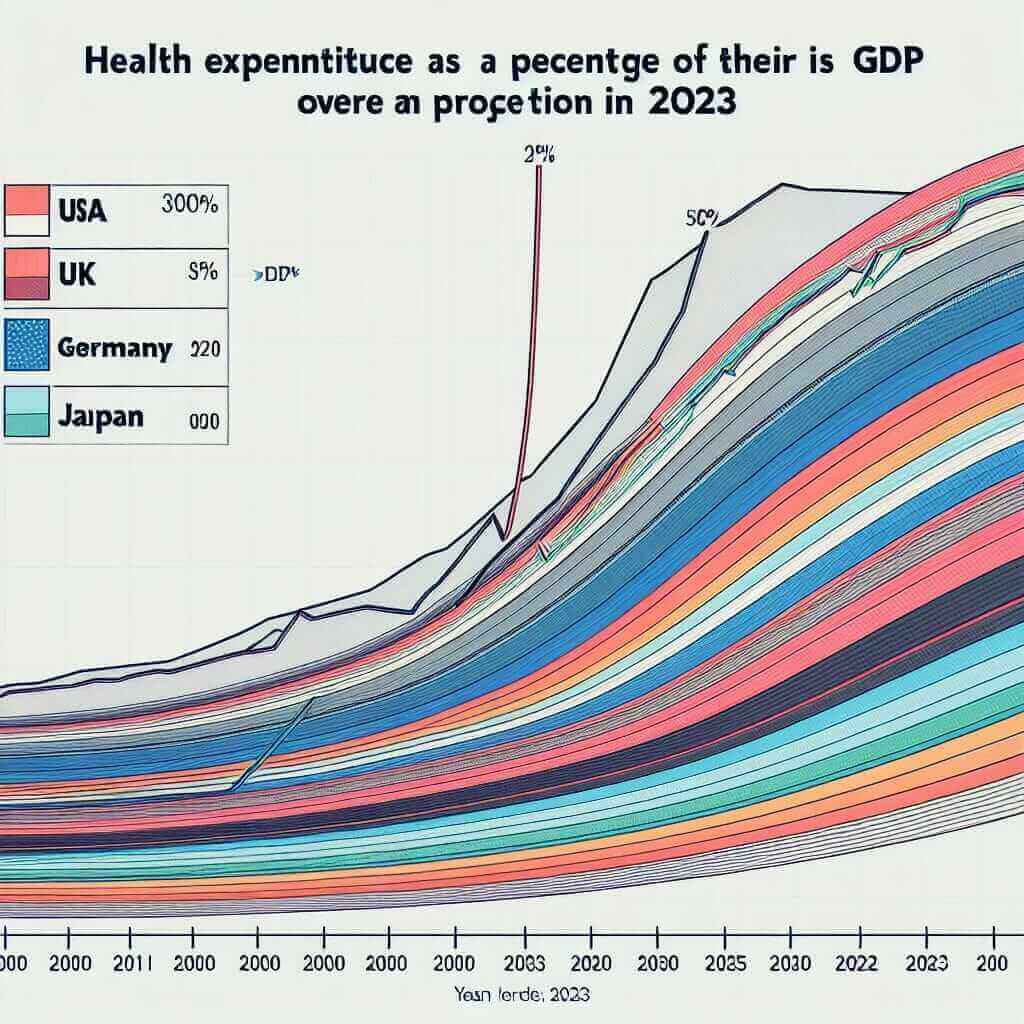In IELTS Writing Task 1, candidates are frequently required to describe and compare data. One common type of question involves comparing health expenditure in different countries over a certain period. This type of task tests your ability to interpret and summarize information from visual data like tables, charts, and graphs.
In this lesson, we will look at how to approach a task involving health expenditure comparisons between different countries from 2000 to 2023. We will provide real-world data, create a sample writing task, and walk you through the process of writing an effective response.
Sample Writing Task
You should spend about 20 minutes on this task.
The table below shows the health expenditure as a percentage of GDP in five countries (USA, UK, Germany, Japan, Australia) for the years 2000, 2012, and 2023.
Summarize the information by selecting and reporting the main features, and make comparisons where relevant.
| Year | USA | UK | Germany | Japan | Australia |
|---|---|---|---|---|---|
| 2000 | 13% | 7% | 10% | 9% | 8% |
| 2012 | 16% | 10% | 11% | 10% | 9% |
| 2023 | 18% | 11% | 12% | 11% | 10% |
Write at least 150 words.

Analyzing the Task
The table presents data on health expenditure as a percentage of GDP in five countries (USA, UK, Germany, Japan, Australia) across three years (2000, 2012, 2023). Here are the key points to note:
- The changes in health expenditure over the years for each country.
- Comparisons between the countries in the same year.
- Identifying trends and patterns.
Model Answer
The table illustrates the proportion of GDP that different countries allocated to health expenditure in 2000, 2012, and 2023.
Overall, it can be seen that health expenditure as a percentage of GDP increased in all five countries over the given period. The USA consistently spent the highest percentage of its GDP on health, whereas the UK had the lowest expenditure in 2000 but saw significant increases by 2023.
In more detail, the USA’s health expenditure rose steadily from 13% in 2000 to 18% in 2023. Similarly, the UK saw a notable increase from 7% to 11% over the same period. Germany experienced a modest rise, starting at 10% in 2000 and reaching 12% by 2023.
Japan and Australia also showed upward trends. Japan’s expenditure went from 9% in 2000 to 11% in 2023, while Australia increased from 8% to 10%. Despite these rises, the USA’s expenditure remained the highest throughout the years, highlighting a significant disparity in health spending among the countries.
In conclusion, while all five countries increased their health expenditure as a percentage of GDP between 2000 and 2023, the USA remained the highest spender each year, with the UK showing the most significant relative increase.
Word Count: 184
Key Vocabulary and Grammar
Vocabulary:
- Expenditure (n) /ˈɛkspəndɪtʃər/: Money spent.
- Proportion (n) /prəˈpɔːrʃən/: A part or share of the whole.
- Allocate (v) /ˈæləkeɪt/: Distribute resources for a particular purpose.
- Notable (adj) /ˈnoʊtəbl/: Worthy of attention or notice.
- Steadily (adv) /ˈstɛdɪli/: Consistently, at a regular pace.
- Disparity (n) /dɪˈspærɪti/: A great difference.
Grammar:
- Comparative Forms: “Higher”, “lower”, “more significant”.
- Superlative Forms: “Highest”, “lowest”.
- Transitional Phrases: “Overall”, “In more detail”, “Similarly”, “In conclusion”.
Writing Tips
- Identify Key Trends: Always identify and articulate the main trends and significant points in the data.
- Use Comparative Language: Comparisons should be clearly expressed using comparatives and superlatives.
- Organize Logically: Organize your response in a logical manner; begin with an overall summary, followed by specific comparisons.
- Keep It Clear and Concise: Aim for clarity and conciseness, avoiding unnecessary details.
Conclusion
To tackle charts or tables in IELTS Writing Task 1 effectively, you need to master the art of identifying trends and comparing data accurately. Practice regularly with different datasets to build your confidence and proficiency. By following the steps outlined above and utilizing the vocabulary and grammar tips provided, you can aim for a high band score in this part of the IELTS exam.
Remember, thorough preparation and a systematic approach are keys to success in IELTS Writing Task 1. Good luck!